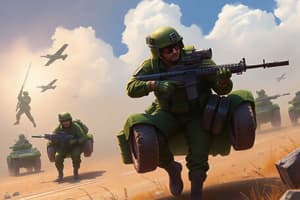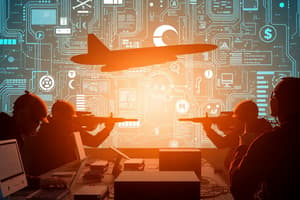Podcast
Questions and Answers
What are the five fundamentals of offensive combat?
What are the five fundamentals of offensive combat?
- Maintain momentum, act quickly, exploit success, be flexible, be aggressive, provide for the security of the force
- Gain and maintain contact, disrupt the enemy, fix the enemy, decisive action and maneuver, follow through (correct)
- Orient on the enemy, gain and maintain contact, develop the situation, concentrate superior firepower at the decisive time and place, achieve surprise
- Exploit known enemy weaknesses, seize or control key terrain, gain and retain the initiative, neutralize enemy's ability to react, advance by fire and maneuver
What are the four types of offensive operations?
What are the four types of offensive operations?
- Penetration (correct)
What are the six forms of maneuver?
What are the six forms of maneuver?
- Movement to contact, Attack, Exploitation, Pursuit
- Frontal attack, flanking attack, envelopment, turning movement, infiltration, penetration (correct)
- Reconnaissance in force, raid, ambush
- Spoiling, counterattack, feint, demonstration
- Sector, Battle Positions, Strong Point, Linear, Perimeter, Reverse Slope
What are the four elements of a movement to contact?
What are the four elements of a movement to contact?
What are the four characteristics of offense?
What are the four characteristics of offense?
What are the three movement techniques?
What are the three movement techniques?
What are the purposes of defensive operations?
What are the purposes of defensive operations?
What are the three types of defensive operations?
What are the three types of defensive operations?
What are the six methods of defense?
What are the six methods of defense?
What are the eight characteristics of defensive operations?
What are the eight characteristics of defensive operations?
What are the three organizational areas of the defense?
What are the three organizational areas of the defense?
What are the steps of engagement area development (EADEV)?
What are the steps of engagement area development (EADEV)?
What are the considerations for an obstacle plan?
What are the considerations for an obstacle plan?
What are the four obstacle effects?
What are the four obstacle effects?
What are the three possible missions for a reserve force in the defense?
What are the three possible missions for a reserve force in the defense?
What is the sequence of the defense?
What is the sequence of the defense?
What are the two types of patrols?
What are the two types of patrols?
What are the four elements of a patrol?
What are the four elements of a patrol?
What are the purposes of a patrol base?
What are the purposes of a patrol base?
What are 'organic elements'?
What are 'organic elements'?
What is a rally point, and what is its purpose?
What is a rally point, and what is its purpose?
How is a cordon and search typically task organized?
How is a cordon and search typically task organized?
What are the five phases of an attack in an urban environment?
What are the five phases of an attack in an urban environment?
What are some key insights to MOUT?
What are some key insights to MOUT?
Flashcards
Fundamentals of offensive combat
Fundamentals of offensive combat
Gain/maintain contact, disrupt, fix enemy, decisive action, follow through.
Fundamentals of offensive operations
Fundamentals of offensive operations
Orient on the enemy, maintain contact, achieve surprise, exploit weaknesses.
Types of offensive operations
Types of offensive operations
Movement to contact, attack, exploitation, pursuit.
Characteristics of offense
Characteristics of offense
Signup and view all the flashcards
Purpose of defensive operations
Purpose of defensive operations
Signup and view all the flashcards
Types of defensive operations
Types of defensive operations
Signup and view all the flashcards
Methods of defense
Methods of defense
Signup and view all the flashcards
Organization of the defense
Organization of the defense
Signup and view all the flashcards
Steps of engagement area development
Steps of engagement area development
Signup and view all the flashcards
Obstacle effects
Obstacle effects
Signup and view all the flashcards
Types of patrols
Types of patrols
Signup and view all the flashcards
Purpose of a patrol base
Purpose of a patrol base
Signup and view all the flashcards
Organic elements
Organic elements
Signup and view all the flashcards
Non-organic elements
Non-organic elements
Signup and view all the flashcards
How to task organize a cordon and search
How to task organize a cordon and search
Signup and view all the flashcards
Key insights to MOUT
Key insights to MOUT
Signup and view all the flashcards
Elements and purpose of a movement to contact
Elements and purpose of a movement to contact
Signup and view all the flashcards
Characteristics of defensive operations
Characteristics of defensive operations
Signup and view all the flashcards
Reserve mission in the defense
Reserve mission in the defense
Signup and view all the flashcards
Sequence of the defense
Sequence of the defense
Signup and view all the flashcards
Characteristics of offensive operations
Characteristics of offensive operations
Signup and view all the flashcards
Forms of maneuver
Forms of maneuver
Signup and view all the flashcards
Study Notes
Offensive Combat Fundamentals
- Gain and maintain contact with the enemy.
- Disrupt enemy operations.
- Fix the enemy in place.
- Employ decisive action and maneuver.
- Follow through with the attack.
Offensive Operations Fundamentals
- Orient on the enemy.
- Gain and maintain contact.
- Assess the situation.
- Concentrate superior firepower at the critical time and location.
- Achieve surprise.
- Exploit enemy weaknesses.
- Seize or control key terrain.
- Maintain the initiative.
- Neutralize enemy reaction capabilities.
- Advance through fire and maneuver.
- Maintain momentum.
- Act swiftly.
- Exploit successes.
- Remain flexible.
- Maintain aggression.
- Ensure force security.
Types of Offensive Operations
- Movement to contact.
- Attack.
- Exploitation.
- Pursuit.
Special Purpose Attacks
- Spoiling attack.
- Counterattack.
- Feint.
- Demonstration.
- Reconnaissance in force.
- Raid.
- Ambush.
Forms of Maneuver
- Frontal attack.
- Flanking attack.
- Envelopment.
- Turning movement.
- Infiltration.
- Penetration.
Movement to Contact Elements and Purpose
- Advanced force.
- Main body.
- Flanking security.
- Rear security.
- Creates favorable conditions to force the enemy's position.
Characteristics of Offense
- Surprise.
- Mass and concentration.
- Controlling tempo.
- Audacity.
Movement Techniques
- Traveling.
- Traveling overwatch.
- Bounding overwatch.
Defensive Operation Purpose
- Defeat enemy attacks.
- Gain time.
- Economize forces.
- Protect the force.
- Develop favorable conditions for offense or stability operations.
- Deny enemy access to key terrain.
- Increase enemy vulnerability.
- Attrite or fix the enemy.
- Prepare to resume offense.
- Support other operations.
- Preoccupy the enemy.
Types of Defensive Operations
- Area defense.
- Mobile defense.
- Retrograde defense.
Methods of Defense
- Sector defense.
- Battle positions.
- Strong points.
- Linear defense.
- Perimeter defense.
- Reverse slope defense.
Characteristics of Defensive Operations
- Flexibility.
- Maneuver.
- Preparation.
- Mass and concentration.
- Terrain utilization.
- Mutual support.
- Depth.
- Surprise.
- Enemy knowledge.
- Local security.
Organization of Defense
- Security area (beyond FEBA).
- Main battle area (MBA).
- Rear area.
Engagement Area Development (EADEV) Steps
- Identify enemy avenues of approach.
- Determine likely enemy methods of assault.
- Identify points to engage and destroy enemy.
- Plan and integrate obstacles.
- Position weapons systems.
- Plan and integrate indirect fires.
- Rehearse the operation.
Obstacle Plan Considerations
- Covered by fires.
- Covered by observation.
- Concealment.
- Depth.
- Protection.
- Integration.
- Non-geometric.
Obstacle Effects
- Disrupt.
- Turn.
- Fix.
- Block.
Reserve Mission in Defense
- Take decisive action.
- Exploit unexpected opportunities.
- Reinforce and exploit main efforts' success.
Sequence of Defense
- Gain and maintain enemy contact.
- Disrupt enemy actions.
- Fix the enemy.
- Maneuver.
- Follow through and counterattack.
Types of Patrols
- Combat: contact, ambush, raid, security.
- Reconnaissance: route, area, zone.
Patrol Organization
- Headquarters.
- Assault element.
- Support element.
- Security element.
Patrol Base Purpose
- Avoid detection.
- Conceal patrol.
- Conduct planning and issue orders.
- Respond to unexpected situations.
- Rest and maintain equipment.
- Reorganize.
- Establish a base for operations.
- Establish communication with other units.
Organic Elements
- Crew-served weapons.
- Organic SUAS.
- Forward air controllers (FACs), joint tactical air controllers (JTACs), joint fire observers (JFOs).
- Scouts.
Non-Organic Elements
- External support (EOD techs, combat engineers).
- Interpreters.
- Intelligence/human intelligence (CI/HUMINT).
- Reactionary forces (RRT).
- Civil affairs.
- Host-nation security forces.
Rally Point Purpose
- Reassemble and reorganize.
- Respond to unexpected obstacles.
- Initial, en route, objective, near, far-side.
Cordon and Search Task Organization
- Assault.
- Support (supportive fires).
- Security (flanks and rear).
Urban Attack Phases
- Recon the objective.
- Isolate the objective.
- Gain a foothold.
- Seize the objective.
- Consolidate.
MOUT Key Insights
- Infantry-intensive.
- Tactical battle impacts other operations.
- Media considerations.
- Maneuver warfare doctrine.
- Intelligence is pivotal.
- Surprise multiplies combat strength.
- Armor/artillery/aviation effective at outer perimeter.
- Armor, protected by infantry, in urban areas.
- Artillery providing direct fire.
- Higher force ratios decrease combat duration.
- Isolation results in defender defeat.
- Urban attacks are costly.
Studying That Suits You
Use AI to generate personalized quizzes and flashcards to suit your learning preferences.




